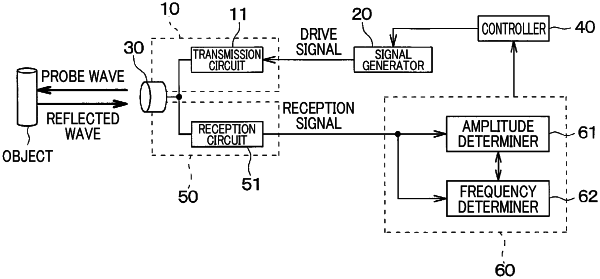| CPC G01S 15/931 (2013.01) [G01S 7/524 (2013.01); G01S 7/526 (2013.01)] | 9 Claims |

|
1. An object detection device comprising:
a signal generator configured to generate a drive signal including an identification signal for identifying ultrasonic waves, the identification signal includes a minimum frequency and a maximum frequency, wherein the minimum frequency and the maximum frequency comprise different frequencies;
a transmitter configured to transmit an ultrasonic wave as a probe wave in response to the drive signal;
a receiver configured to receive the ultrasonic wave to generate a reception signal; and
a non-transitory memory storing one or more computer programs; and
a processor executing the one or more computer programs configured to:
analyze frequencies of the reception signal to determine whether the received wave is a reflected wave of the probe wave, thereby detecting an object,
wherein
the drive signal includes a ramp-up signal generated to be followed by the identification signal and is used to ramp up an amplitude of the probe wave, and
a frequency of the ramp-up signal is set to include a frequency at which
a transmission efficiency of the transmitter is higher than a transmission efficiency of the transmitter at each of the maximum frequency of the identification signal and the minimum frequency of the identification signal and/or
a reception efficiency of the receiver is higher than a reception efficiency of the receiver at each of the maximum frequency of the identification signal and the minimum frequency of the identification signal, and
the frequency of the ramp-up signal is set to include a frequency between the minimum frequency and the maximum frequency of the identification signal.
|